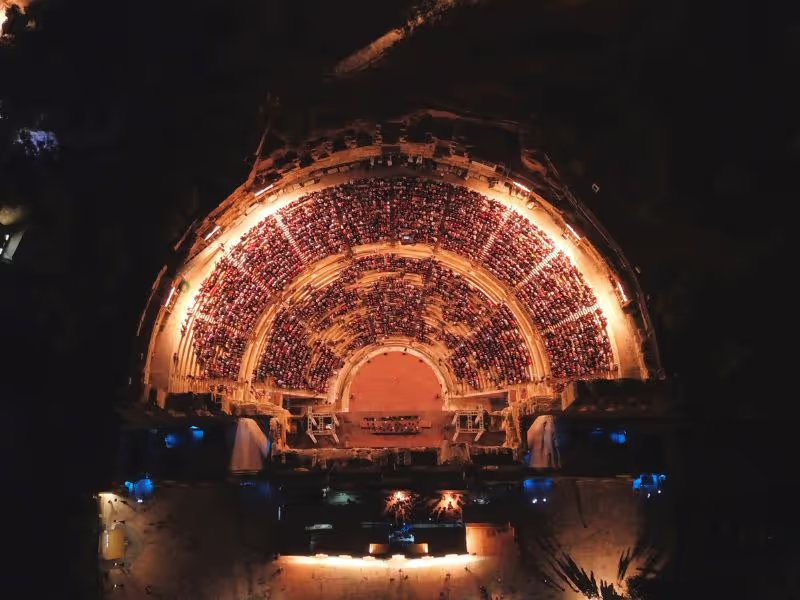

The Odeon of Herodes Atticus is an exemplary testament to the sophistication of ancient architectural designs. Its primary elements comprise the semicircular amphitheater carved into the rock of the Acropolis and a grand stage building.
The entire venue features a notable use of Pentelic marble, a material prized for its fine grain and golden hue. The seating area or auditorium, known as the cavea, is composed of a semi-circle layout, providing optimal views for spectators. Supporting the cavea is a solid wall that delineates the theatre's perimeter.

This open-air theatre has a remarkable diameter of approximately 80 meters, accommodating an audience of 5,000, which attests to its substantial capacity.
Centrally located is the circular orchestra, once likely featuring a wooden roof to improve acoustics. The attention to acoustic detail is further exemplified through the selective use of black and white marble in a checkerboard pattern, aiding sound quality. The stage building, or skene, boasts finest building techniques of the era, contributing to the venue's historic use for hosting ancient Greek tragedies.

Following its initial construction, the Odeon of Herodes Atticus experienced a period of decline. However, extensive excavation and rebuilding efforts in the 1950s restored it to grandeur, making it one of Greece's most significant archaeological sites. The restoration took care to preserve the original elements such as the marble seating, while introducing modern materials for durability. Today, the Odeon's preservation is a continued effort that maintains its status as one of the globe's most exquisite surviving structures from antiquity, capable of hosting performances that offer an experience reminiscent of its historical peak.






3,000+ reviews
Make the most of your time with skip-the-line entrance to the Acropolis. Immerse yourself in the rich history by discovering myths, anecdotes, and the political endeavors of ancient Athenians on an audio guided tour. Multi-attraction pass also available.
Best price:
€37






24,300+ reviews
Make the most of your time with skip-the-line entrance to the Acropolis. Immerse yourself in the rich history by discovering myths, anecdotes, and the political endeavors of ancient Athenians on an audio guided tour. Multi-attraction pass also available.
Best price:
€36






2,000+ reviews
Uncover the secrets of the Acropolis, Dionysus Theater, and Sanctuary with the guidance of a licensed expert. Take advantage of the opportunity to ask any questions during your 90-minute tour and gain a deeper understanding of the history and significance of these ancient sites.
Best price:
€67

Throughout its history, the Odeon of Herodes Atticus has showcased a dazzling array of performers, becoming a beacon for global talent. Luciano Pavarotti and Maria Callas enhanced the venue's awe with their operatic brilliance. Greek tragedies, once echoing off its ancient stones, gave way to the voices of contemporary artists like Sting and Elton John, whose concerts have lent the space a modern resonance. The inclusion of celebrated figures like Nana Mouskouri, Frank Sinatra, Liza Minnelli, and Yanni have further diversified the performance schedule over the years.
The Odeon plays host to significant events that highlight its cultural importance. Every year, the Athens and Epidaurus Festival features a rich program of theatre, music, dance, and opera, showcasing both Greek and international works. The Athens State Orchestra and the Greek National Opera often headline the events, preserving and promoting the fine arts. Performances of ballets and the appearance of renowned figures like Andrea Bocelli are a testament to the Odeon's continuing appeal to high-profile international artists and ensembles.
Tickets for events can typically be purchased online through the official ticketing websites or at the box office near the venue. It is advisable to confirm the availability of tickets and purchase them in advance due to high demand during the event season.
The official schedule for events is usually posted on the official website of the Odeon of Herodes Atticus and may also be available at tourist information centers in Athens.
The entry fee is included in any Acropolis ticket. There is a cost for attending performances.
The Odeon of Herodes Atticus is a Roman structure known for its stone construction with a roof made of cedar of Lebanon, distinguishing it from the older, open-air Theatre of Dionysus which was primarily used for the annual Dionysia festival.
Guided tours are often available, providing insightful historical context and details about the structure. They can typically be booked through the official website or by contacting authorized tour providers in Athens.